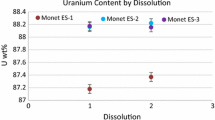Abstract
The production of glass that emulates fallout is desired by the nuclear forensics community for training and measurement exercises. The composition of nuclear fallout is complex, with widely varying isotopic compositions (Fahey et al., Proc Natl Acad Sci USA 107(47):20207–20212, 2010; Bellucci et al., Anal Chem 85:7588–7593, 2013; Wallace et al., J Radioanal Nucl Chem, 2013; Belloni et al., J Environ Radioact 102:852–862, 2011; Freiling, Science 139:1058–1059, 1963; Science 133:1991–1999, 1961; Bunney and Sam Government Report: Naval Ordinance Laboratory, White Oak, 1971). As the gaseous cloud traverses from hotter to cooler regions of the atmosphere, the processes of condensation and nucleation entrain environmental materials, vaporized nuclear materials and fission products. The elemental and isotopic composition of the fission products is altered due to chemical fractionation (i.e. the fission product composition that would be expected from fission of the original nuclear material is altered by differences in condensation rates of the elements); the fallout may be enriched or depleted in volatile or refractory fission products. This paper describes preliminary work to synthesize, irradiate and fractionate the fission product content of irradiated particulate glass using a thermal distillation 2 h after irradiation. The glass was synthesized using a solution-based polymerization of tetraethyl orthosilicate. (Izrael, Radioactive fallout after nuclear explosions and accidents, 2002) Uranium was incorporated into the glass particulate at trace concentrations during polymerization. The particulate was subjected to a short thermal neutron irradiation then heated to 1,273 K approximately 2 h after the end of irradiation. Fission products of 133, 134, 135I, 132, 134Te, 135Xe, 138Cs and 91, 92Sr were observed to be distilled from the particulate. The results of these preliminary studies are discussed.










Similar content being viewed by others
Notes
Lynx is a registered trademark of Canberra Industries, Inc.
References
Fahey AJ, Zeissler CJ, Newbury DE, Davis J, Lindstrom RM (2010) www.pnas.org/cgi/doi/10.1073/pnas.1010631107. Accessed 9 Nov 2010
Bellucci JJ, Simonetti A, Wallace C, Koeman EC, Burns PC (2013) Lead isotopic composition of trinitite melt glass: evidence for the presence of Canadian Industrial Lead in the first atomic weapon test. Anal Chem 85:7588–7593
Wallace C, Bellucci JJ, Simonetti A, Hainley T, Koeman EC, Burns PC (2013) A multi-method approach for determination of radionuclide distribution in trinitite. J Radioanal Nucl Chem. doi: 10.1007/s10967-013-2497-8
Belloni F, Himbert J, Marzocchi O, Romanello V (2011) Investigating incorporation and distribution of radionuclides in trinitite. J Environ Radioact 102:852–862
Freiling EC (1963) Theoretical basis for logarithmic correleations of fractionated radionuclide compositions. Science 139:1058–1059
Freiling EC (1961) Radionuclide fractionation in bomb debris. Science 133:1991–1999
Bunney LR, Sam D US (1971) Government Report: Naval Ordinance Laboratory, White Oak. Maryland, Noltr 71–103
Izrael YA (2002) Radioactive fallout after nuclear explosions and accidents. Elsevier, Saint Louis
Gibson TA (1968) Observed fractionation in ground level fallout from three nuclear cratering detonations. University of California, Lawrence Radiation Laboratory report: TID-4500 UC-35, San Diego
Carney K, Finck M, Brush B, Jansen D, Dry D, Brooks G, Chamberlain D (2013) J Radioanal Nucl Chem 296:769–773
Vasconcelos WL (1998) Connectivity in sol–gel silica glasses. Química Nova 21(4):514–516
Santos AMM, Vasconcelos WL (2000) Properties of porous glasses prepared via sol–gel processes. J Non-Cryst Solids 273:145–149
Gauld I, Hermann OW, Westfall RM (2009) Origen-S: scale system module to calculate fuel depletion, actinide transmutation, fission product buildup and decay, and associated radiation source terms. ORNL/TM-2005/39 Version 6 vol. II, Sect. F7
England TR, Rider BF (1993) Los Alamos National Laboratory, LA-UR-94-3106; ENDF-349
Crocker GR (1967) US Navel Radiological Defense Laboratory report, USNRDL-TR-67-III
Rudstam G (1994) International Nuclear Data Committee report INDC(SWD)-024 International Atomic Energy Agency Nuclear Data Section, Wagramer strasse 5, A-1400 Vienna, Austria
Nichols AL, Aldama DL, Verpelli M (2008) International Atomic Energy Agency International Nuclear Data Committee report INDC(NDS)-0534 Nuclear Data Section International Atomic Energy Agency Vienna, Austria
Jacob KT, Waseda Y (1988) The vapour pressures of barium and strontium. J Less Common Met 139:249–259
Brooks LS (1952) The vapor pressures of tellurium and selenium. J Am Chem Soc 74:227–229
Acknowledgments
The authors acknowledge the US Department of Energy’s Office of National Technical Nuclear Forensics for funding this work. We also acknowledge the contributions of Mr. Fred Gholsen and Mr. Andrew Smolinksi and the INL’s neutron radiography Training Research Isotopes General Atomic (TRIGA) reactor staff for providing sample irradiations. Also recognized are: Mr. Jeffrey Berg for dissolution of the glass samples, and Mr. Marcos Jimenez for performing the isotope dilution mass spectrometry measurements.
Author information
Authors and Affiliations
Corresponding author
Rights and permissions
About this article
Cite this article
Carney, K.P., Finck, M.R., McGrath, C.A. et al. The development of radioactive glass surrogates for fallout debris. J Radioanal Nucl Chem 299, 363–372 (2014). https://doi.org/10.1007/s10967-013-2800-8
Received:
Published:
Issue Date:
DOI: https://doi.org/10.1007/s10967-013-2800-8




